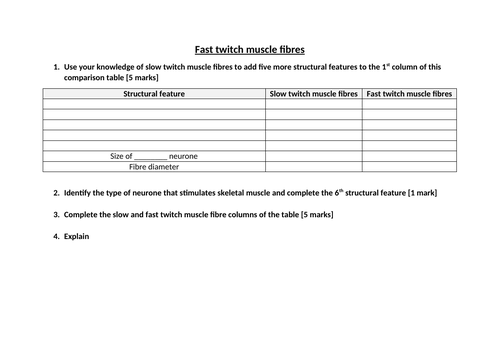




This fully-resourced lesson describes the structural and physiological differences between fast and slow twitch muscle fibres. The detailed PowerPoint and accompanying resources have been designed to cover point 7.10 (ii) of the Pearson Edexcel A-level Biology A (Salters Nuffield) specification and due to the obvious links, this lesson also challenges the students on their knowledge of respiration from earlier in topic 7 and cell structures and biological molecules from topics 1, 2 and 3
The following structural and physiological characteristics are covered over the course of this lesson:
- Reliance on the aerobic or anaerobic pathways to generate ATP
- Resistance to fatigue
- mitochondrial density
- capillary density
- myoglobin content (and colour)
- fibre diameter
- phosphocreatine content
- glycogen content
A wide variety of tasks are used to cover this content and include knowledge recall and application of knowledge exam-style questions with fully-displayed mark schemes as well as quick quiz competitions to maintain motivation and engagement.
This lesson has been specifically planned to tie in with the previous lesson in this topic covering the contraction of skeletal muscles by the sliding filament mechanism
Something went wrong, please try again later.
This resource hasn't been reviewed yet
To ensure quality for our reviews, only customers who have purchased this resource can review it
Report this resourceto let us know if it violates our terms and conditions.
Our customer service team will review your report and will be in touch.